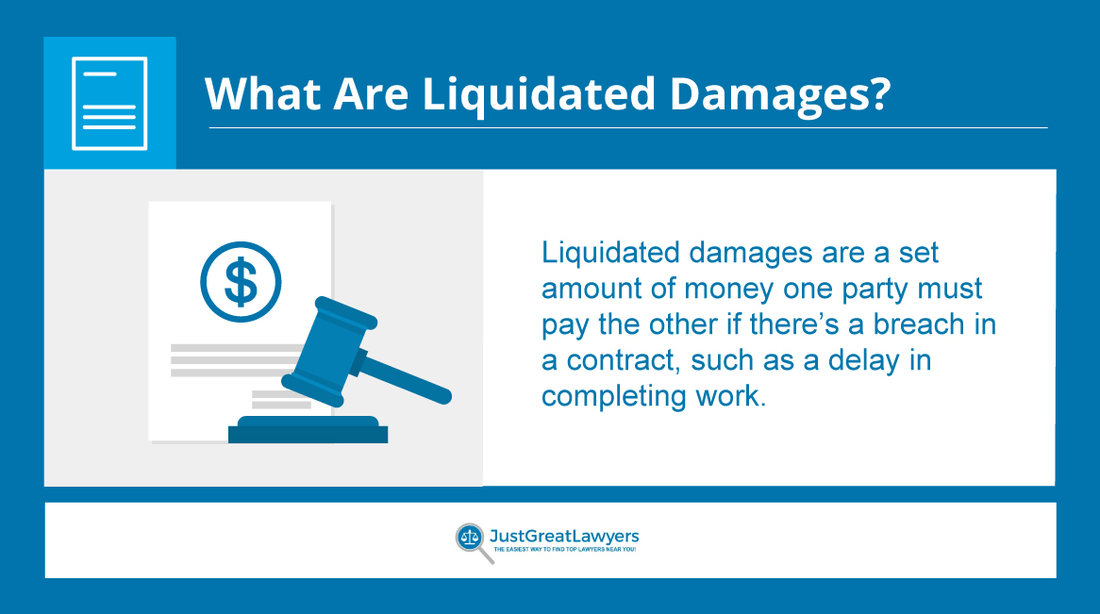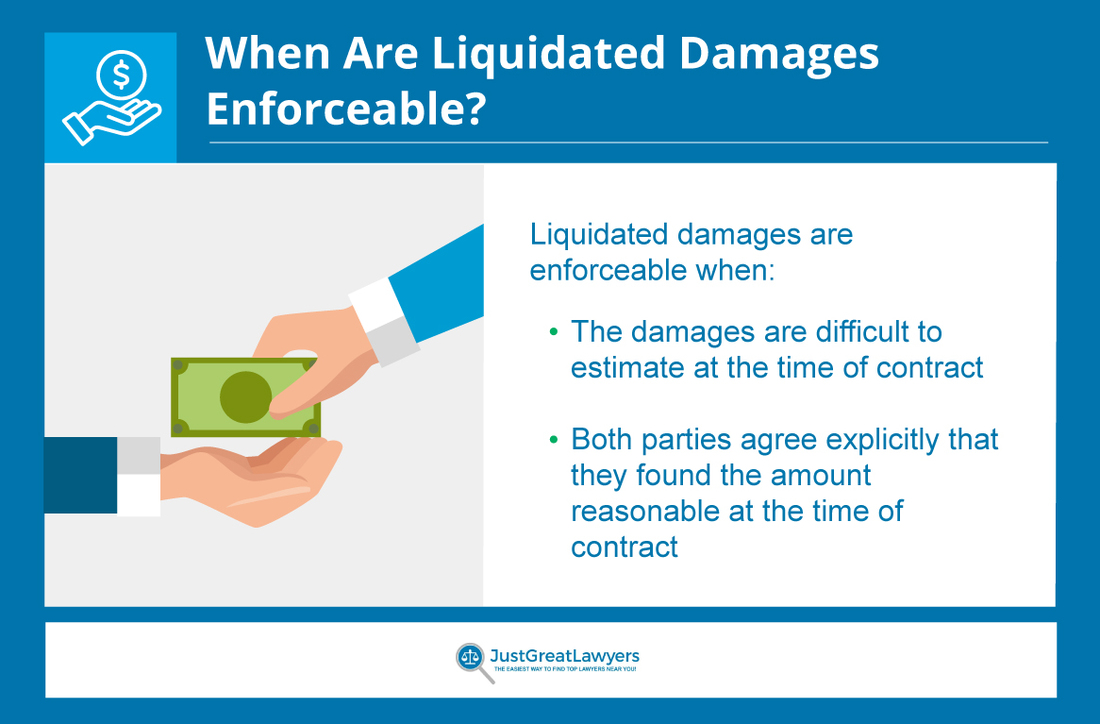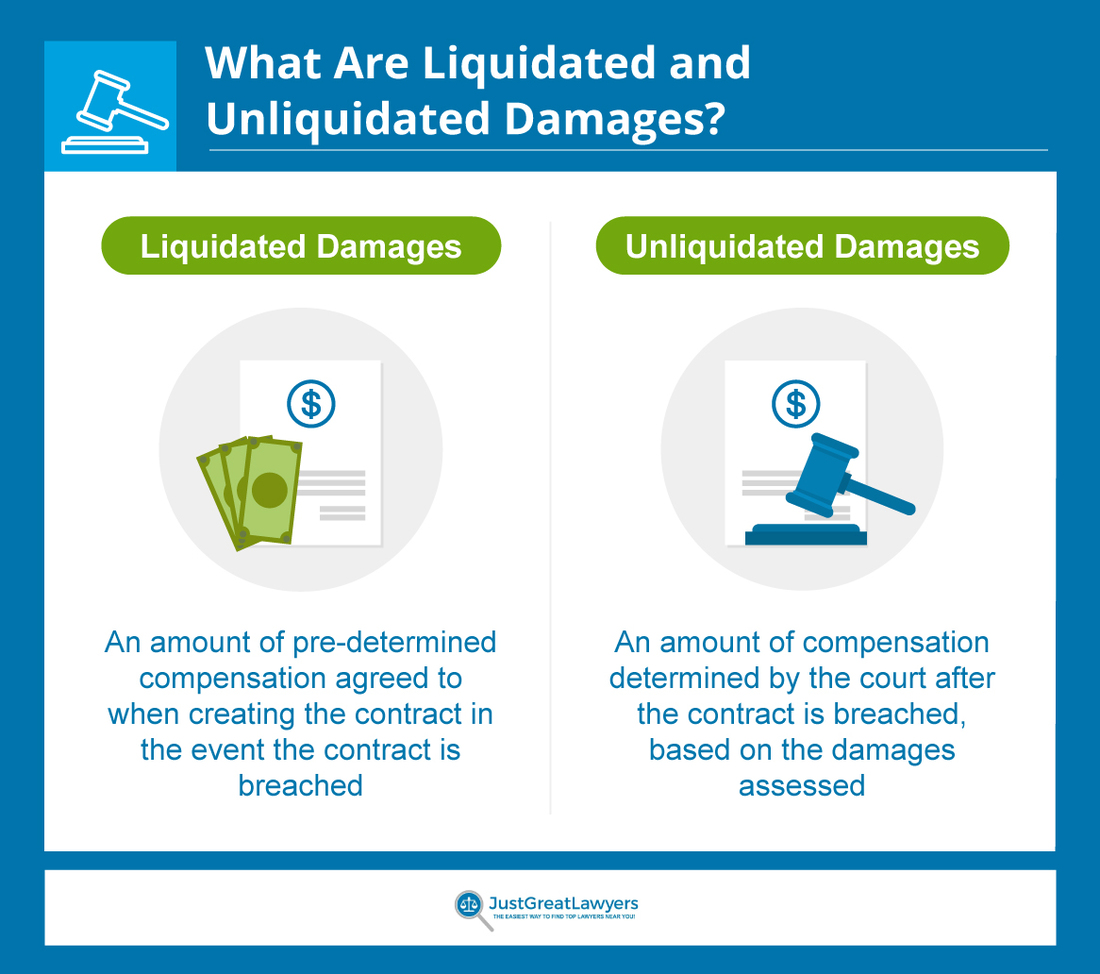
Liquidated damages refer to an amount of money that two parties agreed upon to serve as compensation should a breach of the contract occur. You can find a liquidated damages clause in most contracts like construction, real estate, employment and non-disclosure agreements (NDA).
When an accurate estimate of damages seems difficult to define ahead of time, a liquidated damages clause offers a solution. At the time of signing the contract, both parties agree to a specific amount of money that they believe to be a reasonable estimate of damages. This way, if one party breaches the contract and financially damages the other party, they can receive some sort of compensation.
In this post, we discuss liquidated damages clauses and give examples of how they function, as well as what makes such clauses enforceable.

Liquidated damages are a reasonable amount of money that will be paid if a contracting party causes damages or breaches the contract. That amount of money becomes compensatory damages, instead of punitive damages because the money being paid out is intended to make the non-breaching party whole again, not punish the wrongdoer.
Commonly, both parties add liquidated damages to a contract when damages are difficult to define or calculate at the time of signing the contract. From trade secrets to construction delays, you can find a range of contracts that may require liquidated damages.
For example, some construction contracts have a clause if the contractor breaches the contract by not completing the project on time. The damages a delay can cause would be hard to determine ahead of time, so both parties agree to an amount that is included in the liquidated damages clause.
When Are Liquidated Damages Enforceable?
Liquidated damages are considered enforceable when:
The damages from a violation of the contract are difficult to determine when the contract is signed.
Both contracting parties agree to the amount.
Both parties consider the amount to be reasonable in conjunction with the actual damages.
If these criteria are followed, the amount can be considered a permissible liquidated damages clause and be enforced. If not, it is simply an unenforceable penalty.
In most states, the process of determining if the liquidated damages are enforceable comes in two parts. First, the court will look at the sum of money to see if it is reasonable, as it must be close to the sum of actual damages or must be the amount of loss reasonably anticipated at the beginning of the contract.
Secondly, the court will see if it is necessary to have the liquidated damages clause in the first place, as this clause is only needed when it is hard to calculate the loss resulting from a breach of contract. If both the numbers and necessity hold up in court, the damages are likely enforceable.

Because of the wide range of circumstances possible, you won’t find a magic formula to calculate liquidated damages. The amount will vary depending on the situation. Consulting experts ahead of the contract and providing documentation of how you arrived at the number you’re asking for will be very helpful should you need to go to court over it.
Make sure that the estimate covers all the losses you could experience from a breach of contract, not just the lost profits. This can include rental costs, storage costs, customer satisfaction and company ratings.
For example, in a software development contract, a liquidated damages clause could come in handy should the developers fail to deliver the finished product on time. Such clauses could cover lost revenue, increased operational costs, missed market opportunities and customer satisfaction issues. Not only does the compensation attempt to make you whole again, but it also helps you get back on your feet.
Another example could be a construction contract with a university. A delay in finishing a building results in so much more than financial loss, as staff assigned to work in that building may have to be laid off, classes that are scheduled there are canceled and alternative spaces have to be found. A liquidated damages clause in the contract could help minimize the damages suffered.
You have to consider multiple factors to estimate liquidated damages, including intangible damages. Depending on the type of contract, liquidated damages may be expressed as a set dollar amount, calculated on a daily basis or adjusted depending on the milestone reached at the time of the breach.
When Are Liquidated Damages Unenforceable?
The court will not enforce the liquidated damages clause if it decides that the clause is acting as a penalty clause or simply added to the contract as a threat to keep the other party in line.
The court determines whether or not the liquidated damages are a reasonable assessment, regardless of actual damages, by looking closely at how the damages were calculated and what amount the parties agreed to.
Liquidated damages are considered unenforceable if:
The intent to liquidate damages isn’t clearly expressed
The amount is disproportionate to the damages
The damages could be easily calculated another way
Determining whether the clause is enforceable or not isn’t cut and dry. It depends on your situation, the jurisdiction and the courts themselves, so consult with a lawyer if you’re unsure.
Examples of Liquidated Damages
You can see how useful liquidated damages clauses are by reviewing these examples:
Construction contracts: You’re an employer looking to repave a city road. If the construction company you hire fails to complete the job in time, causing traffic jams and delays, you could be paid a certain amount per day of delay as compensation if you added a liquidated damages clause to your construction projects.
Real estate contracts: If you’re a homeowner looking to sell your home, and the buyer failed to follow through with the purchase, you could be paid a predetermined sum for damages, such as taking your house off the market for no reason.
Employment contracts: If you are an employer for a big tech company, you might add a liquidated damages clause to your non-compete agreement. This way, if one of your employees leaves your company to work for a competitor within a certain time period, thus endangering your intellectual property, you could be paid a certain amount of money as liquidated damages. However, keep in mind that contract law, which governs both liquidated damages clauses and non-compete agreements, can vary from state to state, so always be sure to double-check your state laws.
Non-disclosure agreements (NDA): NDAs often contain liquidated damages clauses to be sure that parties don’t disclose confidential information. If someone signed an NDA but continued to discuss information they promised not to, they would be liable to pay a predetermined amount as liquidated damages. However, this is not a green light to increase the liquidated damages just to threaten someone into following the contract, since a court could find that number unenforceable.
Example of Liquidated Damages Clause
Kent State University v. Ford is an example of liquidated damages at work. In 2010, KSU and their basketball coach Gene Ford negotiated his new salary of $300,000 and a contract that stipulated Ford would stay with KSU for five years. This contract also contained a liquidated damages clause which spoke on KSU’s investment in Ford and asked that if he left before the five years ended, he would pay his salary of $300,000 multiplied by the number of years remaining in the contract. In 2011, Ford left KSU and accepted a position at Bradley University, therefore breaching this contract.
A liquidated damages clause is considered enforceable when the losses could not be calculated ahead of time and the amount of money requested is reasonable. The loss of Ford would be hard for KSU to calculate in terms of liquidated damages since losing a coach could impact recruitment, decrease the team’s performance, decrease ticket sales and cost both time and money to find a replacement. The court found the amount of money in the clause to be reasonable. Since it was necessary for there to be a liquidated damages clause due to the difficulty in assessing the loss of Ford and the number requested was reasonable, the court upheld the liquidated damages clause as enforceable.
How Are Liquidated Damages Different from Penalty Clauses?
A liquidated damages clause is a reasonable number that tries to predict the entirety of the harm done by a breach of contract, but a penalty clause is an unreasonably high number, serving as a punishment for a breach of contract. Liquidated damages are compensatory and meant to make the other party whole again, while punitive damages are punishment for the behavior of the party that breached the contract. Rather than be factored into the contract, courts typically award punitive damages at its discretion.
In some contracts, liquidated damages are listed as a consequence of a breach. Courts will make sure that the liquidated damages are not punitive damages through a two-step process.
They will first make sure the amount of damages asked for is reasonable given the harm caused by the breach of contract, and then they will see if the damage done by the breach of contract was so harmful that it wasn’t considered in the original estimation. If the court finds both of these hold up, they will usually uphold the liquidated damages clause.

Unliquidated damages are not included in a contract and require the defendant to prove the actual harm done to receive compensation. Unlike liquidated damages, the court assesses the actual loss and decides if and how much compensation the defendant receives.
By claiming unliquidated damages, you run the risk of the court refusing to award you any compensation. It is much better to include a liquidated damages clause in your contract so you can ensure that you will receive compensation should there be a breach of contract.
What to Do If the Contract Was Breached?
An excellent way to determine what you do in the event of a breach is to add a dispute resolution clause. This could be less expensive than litigation and gives both parties a clear path to follow.
If you experience a breach of contract and the other party won’t abide by the liquidated damages clause, the dispute resolution provision makes it very clear what you will do next.
You can choose from the following ways to resolve your dispute:
Arbitration: In arbitration, a neutral arbitrator or panel of arbitrators hears both sides and makes a decision. This decision is enforceable by the courts and is almost always final.
Mediation: Mediation is not binding and is usually just a compromise between the two parties before they move on to another means of dispute resolution.
Litigation: Both parties go to court. It can be time-consuming and expensive, but the court’s decision will also be final.
Find a Lawyer For Your Contract
If you think adding a liquidated damages clause to your contract is the best move for you, then hiring a lawyer or law firm to help you draw it up is important. The enforceability of a liquidated damages clause will vary based on your jurisdiction and the situation, so it’s important to find a lawyer experienced with contract law in your state.
Just Great Lawyers can give you legal advice and help you find a lawyer that can aid you in writing an effective and enforceable liquidated damages provision.
